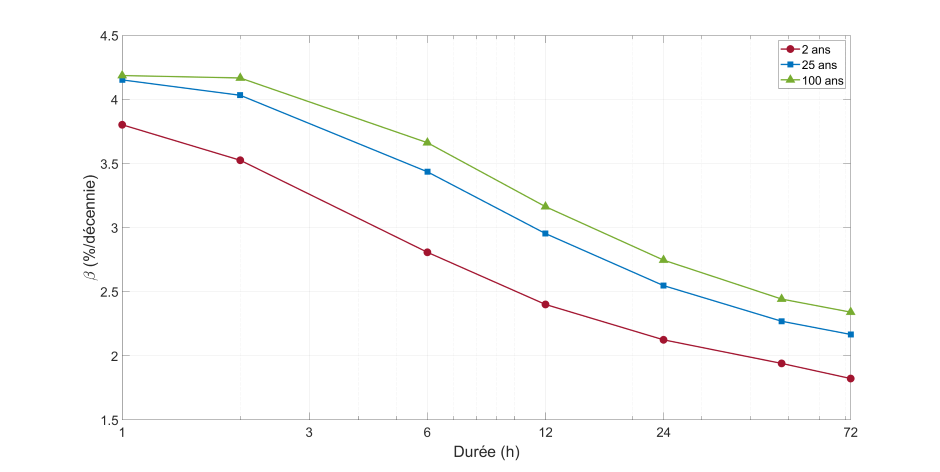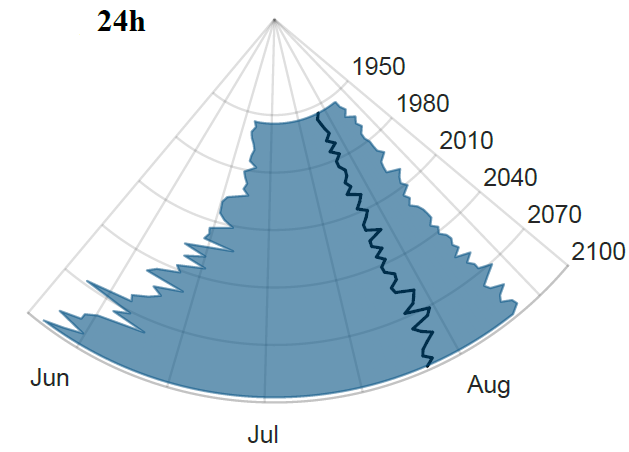Extreme precipitation and laws of scale: impacts of climate cycles and natural climate variability
This study confirms that the use of scaling laws provides a better characterization of extreme precipitation. Their application will allow for better use of available observational data and thus a better characterization of historical climate, particularly at temporal and spatial resolutions not covered by observational data.
Project details


Context
Historically, the collection of rainfall data was done from precipitation stations throughout the territory. Although these provide a direct measurement of precipitation, the low density of the rain gauges and the short time period which any given measurement applies to significantly limit our ability to represent and analyze the spatial and temporal structure of rainfall events, particularly with respect to the most intense events.
However, a characterization of extreme rainfall events at fine spatial and temporal scales is often necessary to assess the impacts of atmospheric phenomena on regional natural ecosystems, or for the design of hydraulic structures. To our knowledge, few studies have examined these scaling laws from large sets of observations. Verifying to which degree these relationships between the different scales apply to various datasets could possibly generate information about precipitation at spatial and temporal resolutions not covered by existing data.
Objective(s)
-
Verify the existence of scaling laws from multiple datasets at different spatial and temporal resolutions; Study the evolution of scaling laws for future climate;
-
Determine the impact of natural climate variability and climate cycles on estimators of intense rainfall.
Methodology
-
Verification of the existence of scaling laws and multi-scales on different datasets for the North American territory and determination of distributions usable to estimate rainfall intensities;
-
Construction of intensity-duration-frequency (IDF) curves from the distributions retained. Comparison of estimates from series based on numerical models (reanalyses and historical regional climate simulations) with estimates based on observed series;
-
Comparison of the scaling laws of the future period (2070−2100) with those obtained for the historical period (1960−1990) from regional climate projections;
-
Application of the detection of a trend or of cycles in order to determine the impact of natural climate variability and climate cycles on intense rainfall estimators.
Results
The first objective was to verify the existence of scaling laws for the statistical properties of annual maxima (AM) precipitation over northeastern North America, using the greatest number of precipitation series measured at meteorological stations (about 2,700 stations). The temporal scaling was validated for a wide range of durations between 15 min and 7 days. The possibility of constructing Intensity-Duration-Frequency (IDF) curves based on an assumption of scale invariance was assessed, taking into account the performance of the scaling laws in approximating extreme quantiles of AM probability distributions. Finally, a domain-wide spatial analysis showed that scaling parameters are influenced by local geographical and climate characteristics, underlining the importance of considering these in estimating IDF curve parameters.
The second objective was to investigate the scaling laws using various datasets: satellite data, an ensemble obtained by interpolating data from multiple sources (satellite, stations and reanalysis), a high-resolution (4 km) regional climate model simulation, and 50-member Canadian Regional Climate Model Large Ensemble (CRCM5-LE) simulations (Leduc et al. 2019). The scale invariance of extreme precipitation was verified for these gridded datasets, both observed and simulated, and made it possible to determine the influence of certain data characteristics (such as temporal resolution) on the representation of extreme precipitation spatiotemporal structure. The scaling laws were compared at different spatial aggregation scales, resulting in the definition of a model spatiotemporal scaling law relating AM probability distribution quantiles over a wide array of spatiotemporal scales. This relationship makes it possible to estimate IDF curves and areal reduction factors (ARF) at sites without meteorological stations.
The third objective was to evaluate the future evolution of AM properties for durations of 1 to 72 hours based on series simulated by CRCM5-LE for the period 1950-2100 (RCP 8.5). The 50-member CRCM5-LE series were combined over short time periods (3 to 7 years), generating sufficient samples to investigate the evolution of extremely rare and more extreme events (e.g., return period of 100 years).

Figure 1 : Median projected relative change (%/decade) by duration for northeastern North America for return periods of 2 years (red), 25 years (blue) and 100 years (green).
The results show a significant increase in AM across the simulation domain between 1950 and 2100, especially for the shortest duration (1 hour) and more extreme events (i.e., longest return periods) (Figure 1). These increases will have major consequences if they are not taken into account in the design of hydraulic structures. The analyses also showed that the annual cycle will be affected by climate change. Thus, the 24-hour AM will be likely to occur earlier in the year (figure 2).

Figure 2 : Distribution over CRCM5-LE simulation domain grid boxes of the mean date of occurrence of 24-hour AM (annual cycle) by year. The blue area corresponds to the interquartile (25-75%) and the black line represents the median.
Scientific publications
Benefits for adaptation
Benefits for adaptation
This study confirms that the use of scaling laws provides a better characterization of extreme precipitation. Their application will allow for better use of available observational data and thus a better characterization of historical climate, particularly at temporal and spatial resolutions not covered by observational data.
The results of the study confirm that extreme precipitation will be more intense in the future climate and thus show the urgency of revising the design criteria for hydraulic structures and infrastructures that will be in place in the coming decades. This study also proposes values that can be used as multipliers
Funding

The CRCM5 was developed by the ESCER centre of UQÀM (www.escer.uqam.ca) in collaboration with Environment and Climate Change Canada.
Other participants
-
Environnement et Changement climatique Canada (ECCC)